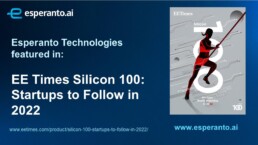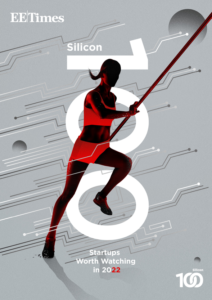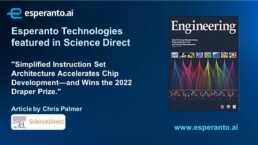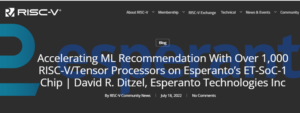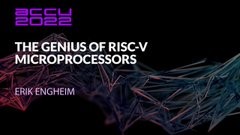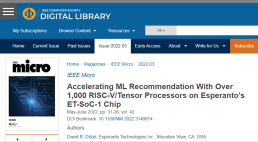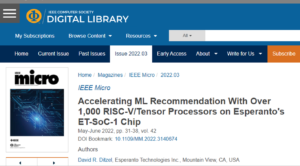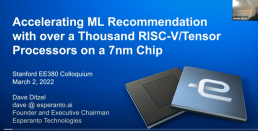Esperanto at Samsung SAFE 2022
Hear Art Swift of Esperanto at the Samsung SAFE™ Forum 2022
Art Swift, President and CEO of Esperanto Technologies, will participate in a panel: "How is Today’s Foundry Ecosystem a Catalyst for Tomorrow’s Innovative Startups?" at the Samsung Advanced Foundry Ecosystem (SAFE) Forum on October 4, 2022.
The Samsung SAFE Forum is October 4, 2022 in San Jose, CA.

About SAFE 2022
For more conference information, https://semiconductor.samsung.com/emea/event/foundry-events-2022-us/
Update:
Missed the Samsung SAFE Forum 2022? Registrants can now watch online.
See the panel "How Ecosystem Enables the Next Level of Innovation in HPC, HIT and Chiplets" with Art Swift of Esperanto Technologies here: https://semiconductor.samsung.com/us/event/safe-forum-2022/

Esperanto in EE Times Silicon 100
Esperanto Technologies is featured in the EE Times Silicon 100: “Startups to Follow in 2022.”
By Peter Clarke:
- “The Silicon 100 is the “who’s who and who’s doing what” in the global electronics and semiconductor industries.
- The EE Times Silicon 100, now in its 22nd edition, is not just a list of electronics and semiconductor startups to watch. It explores the non-linear relationship between capital investment and technological innovation and draws a nuanced picture of the changing dynamics and trends in the global startup ecosystem.
- Peter Clarke, a veteran technology and business journalist who has compiled and curated the EE Times Silicon 100 list since its inception in 2004, has ranked the most promising startups in a weighted selection of fresh-faced youngsters, familiar faces, and fast growers.”
Purchase the full report here...
Esperanto Featured in Science Direct
New article by Chris Palmer, in Science Direct.
"Simplified Instruction Set Architecture Accelerates Chip Development—and Wins the 2022 Draper Prize."
Discussion of the RISC-V momentum, with detailed information from Esperanto Technologies.
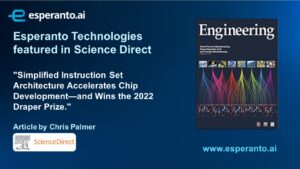
Citation: C. Palmer, Simplified Instruction Set Architecture Accelerates Chip Development—and Wins the 2022 Draper Prize, Engineering (2022), doi: https://doi.org/10.1016/j.eng.2022.08.003
Esperanto in RISC-V Community News
RISC-V Foundation Community News Blog:
"Accelerating ML Recommendation with Over 1,000 RISC-V/Tensor Processors on Esperanto’s ET-SoC-1 Chip."
With Dave Ditzel, Esperanto Technologies.
.
The Genius of RISC-V Microprocessors – ACCU 2022
Watch the video: "The Genius of RISC-V Microprocessors."
With Erik Engheim at the ACCU Conference 2022.
Esperanto Technologies' ET-SoC-1 is featured at 15:00
.
RISC-V in Electronic Design
Article in electronicdesign.com: “RISC-V Serves Up Open-Source Possibilities for the Future.”
.
IEEE Micro: Accelerating ML Recommendation
In IEEE Micro with Dave Ditzel: "Accelerating ML Recommendation With Over 1,000 RISC-V/Tensor Processors on Esperanto's ET-SoC-1 Chip."
Stanford Video: Accelerating ML Recommendation with over a Thousand RISC-V/Tensor Processors
Stanford Video with Dave Ditzel: "Accelerating ML Recommendation with over a Thousand RISC-V/Tensor Processors on a 7nm Chip."
ITNEXT.io: RISC-V Is Actually a Good Design
ITNEXT.io article by Erik Engheim: "Yeah, RISC-V Is Actually a Good Design"
- "Well known people in the industry such as Dave Jaggar, Jim B. Keller and Dave Ditzel give RISC-V the thumbs up."
Hackster.io: Esperanto Technologies Begins Trialing 1,093-Core ET-SoC-1 RISC-V ML Accelerator
Esperanto Technologies Begins Trialing 1,093-Core ET-SoC-1 RISC-V Machine Learning Accelerator
Initial results from the company's early access program promising — and you can apply as a member now to receive a test chip of your own.
by Gareth Halfacree in Machine Learning & AI



